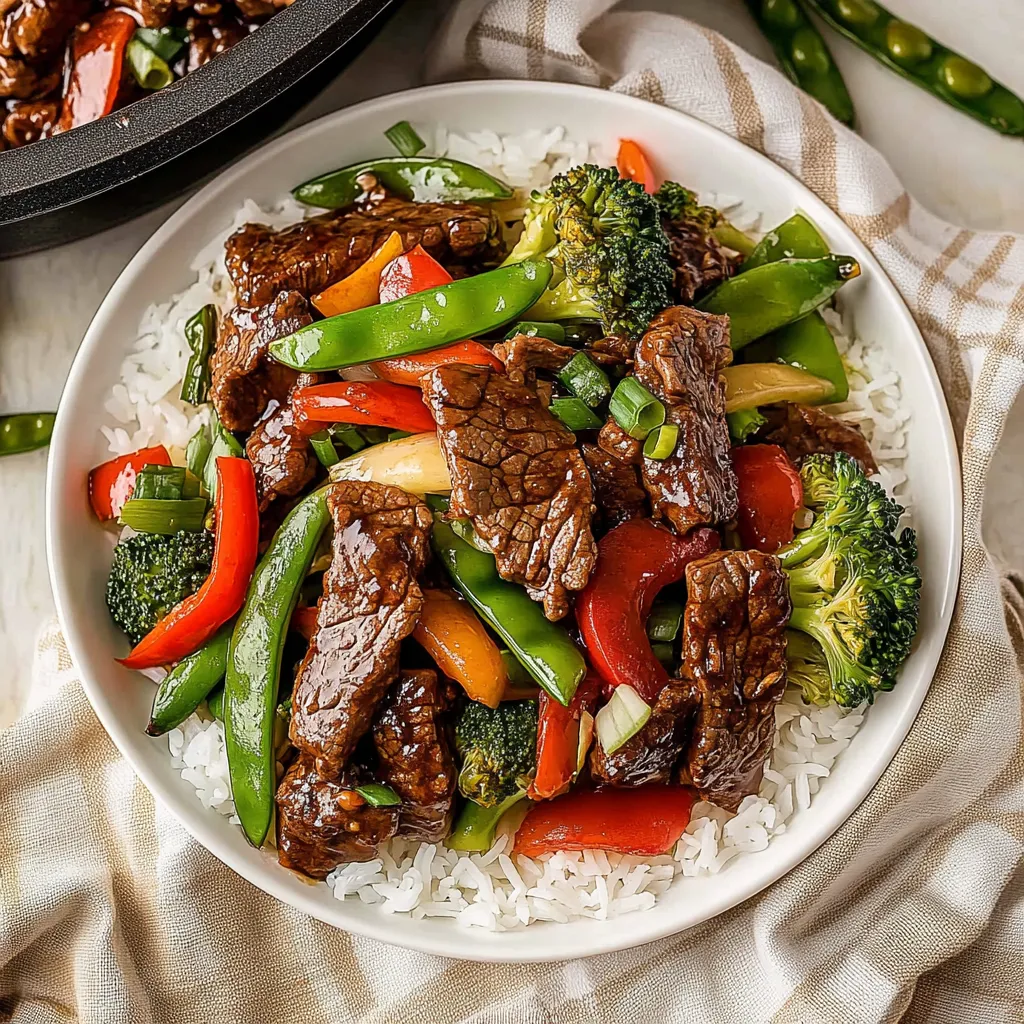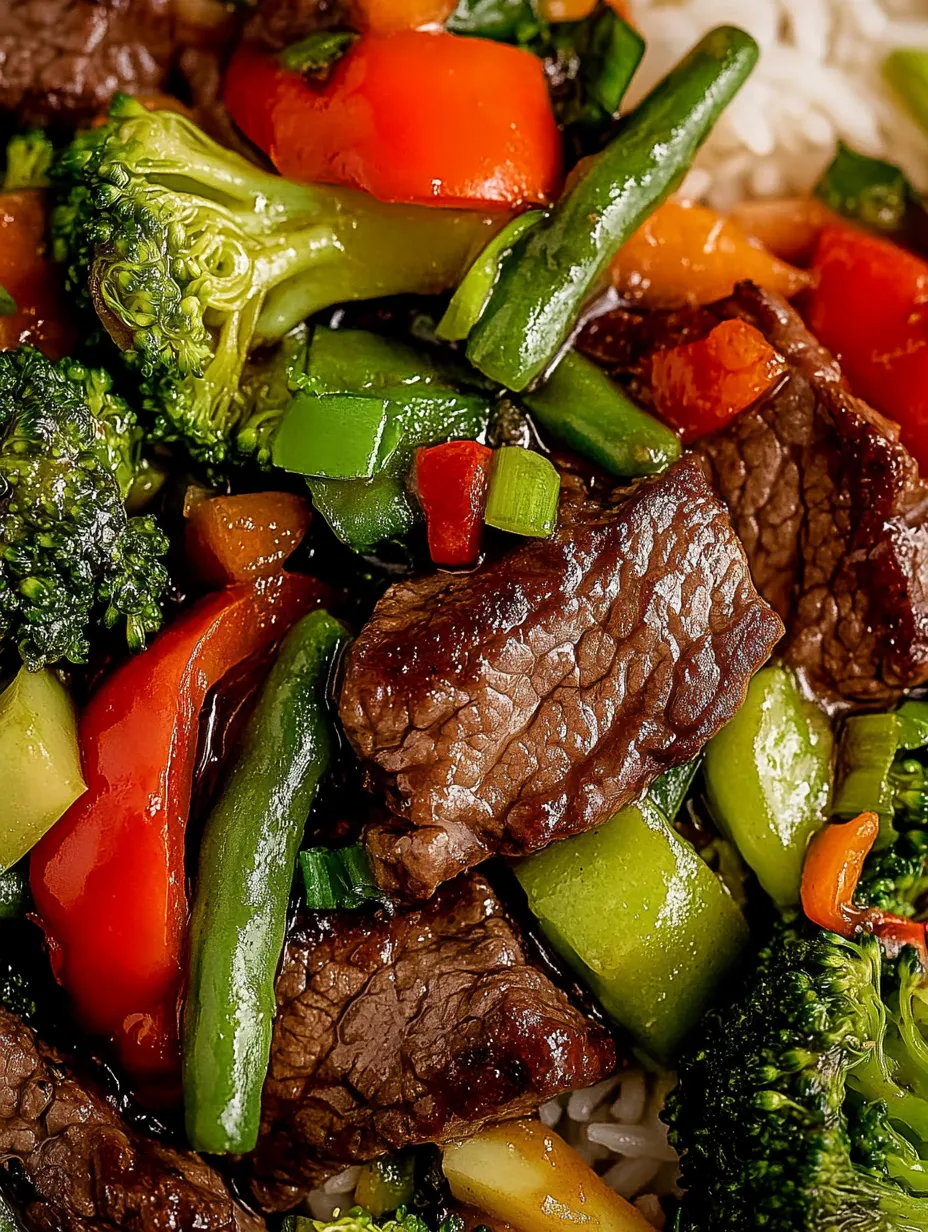 Pin it
Pin it
This vibrant stir fry combines tender strips of flank steak with a rainbow of fresh vegetables, all enveloped in a silky homemade sauce that puts takeout to shame. The secret lies in the perfect balance of savory soy sauce, bright orange juice, and aromatic ginger and garlic. I developed this recipe after countless disappointing takeout experiences left me craving something fresher and more flavorful without the long wait or hefty price tag.
I first created this recipe during a particularly busy season when my family needed quick, nutritious dinners. What started as a fridge clean out experiment quickly became our go to meal when we crave something satisfying yet wholesome. My husband, who normally pushes vegetables to the side of his plate, devours every colorful bite.
Stellar Ingredients
- Flank Steak (2 pounds): The ideal cut for stir frying thanks to its rich flavor and how beautifully it tenderizes when sliced properly against the grain
- Low Sodium Soy Sauce (½ cup): Provides essential umami depth without overwhelming saltiness; coconut aminos make an excellent substitute for gluten free needs
- Fresh Orange Juice (¼ cup): Brings natural sweetness and bright acidity that balances the savory elements while helping tenderize the meat
- Rice Vinegar (1 tablespoon): Adds subtle tang that cuts through richness and awakens the palate with each bite
- Fresh Grated Ginger (½ teaspoon): Contains aromatic oils that infuse the entire dish with warmth and distinctive Asian flavor profile
- Garlic Cloves (2): Forms an essential flavor foundation that develops complexity as it cooks with other ingredients
- Honey or Brown Sugar (1 tablespoon): Creates caramelization on the meat and balances the saltiness and acidity of other sauce components
- Cornstarch (1 tablespoon): Transforms the liquid ingredients into a glossy sauce that clings perfectly to every piece of meat and vegetable
- Sesame Oil (2 tablespoons): Imparts distinctive nutty flavor and high heat cooking capability essential for proper stir frying
- Colorful Vegetables: The red bell pepper, broccoli, carrots, snow peas, and baby bok choy provide varying textures and nutritional benefits
Kitchen Choreography
- Sauce Symphony:
- Begin by measuring all sauce ingredients into a medium bowl. Whisk together the low sodium soy sauce, freshly squeezed orange juice, rice vinegar, freshly grated ginger, and minced garlic cloves until well combined. Add the honey or brown sugar and stir until completely dissolved. In a small separate bowl, create a slurry by mixing the cornstarch with two tablespoons of cold water until smooth. Whisk this slurry into the sauce mixture until fully incorporated. Set this flavor base aside while you prepare the remaining ingredients, allowing the flavors to meld and develop complexity.
- Meat Mastery:
- For perfectly tender steak, place the flank steak in the freezer for approximately 20 minutes to firm up slightly but not freeze solid. This makes creating thin, even slices much easier. Remove the steak and pat completely dry with paper towels, which ensures better browning. Identify the direction of the muscle fibers and position your knife perpendicular to them. Slice the steak across the grain into strips no thicker than ¼ inch. Season the sliced meat evenly with kosher salt and freshly ground black pepper, tossing to coat all pieces. Allow the seasoned meat to rest at room temperature for 10 minutes to take the chill off before cooking.
- Vegetable Virtuosity:
- While the meat rests, prepare all your vegetables to ensure consistent cooking. Slice the red bell pepper into thin strips after removing seeds and membranes. Cut broccoli into small, even florets that will cook quickly and absorb sauce efficiently. Peel and slice carrots on a diagonal to create more surface area for flavor absorption. Trim the ends of snow peas and remove any strings. Separate the baby bok choy leaves from the stalks, chopping the stalks into bite sized pieces while keeping the tender leaves whole to add at the very end of cooking.
- Cooking Crescendo:
- Heat a large wok or heavy skillet over high heat until a drop of water instantly evaporates upon contact. Add one tablespoon of sesame oil and swirl to coat the cooking surface. Working in small batches to avoid overcrowding, add strips of flank steak in a single layer. Allow them to sear undisturbed for 60 seconds before flipping or stirring. Cook for just another 30 45 seconds until the exterior is browned but interior remains slightly pink. Transfer to a clean plate and repeat with remaining steak, adding more oil only if needed between batches.
- Vegetable Victory:
- Return the wok to high heat and add the remaining sesame oil. Add the vegetables in order of density, beginning with broccoli and carrots. Stir fry constantly for two minutes, then add bell pepper and snow peas. Continue cooking for another two minutes until vegetables are bright and beginning to soften but still retain pleasant crispness. Give your prepared sauce a final whisk to reincorporate any settled cornstarch before pouring it into the hot wok. Stir constantly as the sauce comes to a simmer and begins to thicken, which should take about 60 90 seconds.
- Final Flourish:
- Once the sauce has thickened to a glossy consistency that coats the back of a spoon, return the seared steak to the wok along with any accumulated juices. Add the reserved bok choy leaves and toss everything together for approximately 30 seconds until the meat is reheated and the bok choy leaves have just wilted. Remove from heat immediately to prevent overcooking the steak or vegetables. Transfer to a large serving platter or individual bowls atop your chosen base. Sprinkle generously with thinly sliced green onions and sesame seeds before serving immediately to capture the perfect balance of textures and temperatures.
 Pin it
Pin it
I particularly love the vibrant colors that fresh vegetables bring to this dish. Growing up, my mother always emphasized "eating the rainbow" for optimal nutrition, and this stir fry certainly delivers on that promise. The snow peas remain my personal favorite element, with their satisfying snap and sweet flavor that pairs perfectly with the savory beef. My children, initially vegetable skeptics, now eagerly help choose which colorful vegetables to include in our weekly stir fry night.
Glorious Companions
This versatile stir fry welcomes various serving options depending on your dietary preferences and what you have available. Traditional steamed jasmine rice provides the perfect blank canvas for soaking up the delicious sauce. For a more aromatic base, try coconut rice prepared with light coconut milk instead of water. Those seeking higher protein options might prefer serving over soba or udon noodles tossed with a touch of sesame oil. For a lighter meal, crisp lettuce cups create a refreshing contrast to the warm stir fry. Cauliflower rice offers a lower carbohydrate alternative that still provides satisfying texture and neutral flavor to complement the bold stir fry.
Creative Adaptations
This foundation recipe welcomes countless variations based on what ingredients you have available or personal preferences. For those who enjoy more robust flavors, add thinly sliced mushrooms which contribute meaty umami notes. Vegetable variations might include thinly sliced zucchini, yellow squash, or water chestnuts for additional crunch. The protein component can easily shift to thinly sliced chicken thighs, pork tenderloin, or even firm tofu for vegetarian preparations. Heat levels adjust beautifully with the addition of sliced fresh chilis or a dollop of chili crisp oil added at the table. For those avoiding cornstarch, arrowroot powder provides similar thickening results with a slightly more translucent finish.
Keeping Leftovers
Allow any leftover stir fry to cool completely before transferring to airtight containers. Properly stored in the refrigerator, this dish maintains excellent quality for up to four days, making it ideal for meal prep. When reheating, add a small splash of water or broth to loosen the sauce which naturally thickens when chilled. Gentle warming in a covered skillet over medium low heat provides the best textural results, though microwave reheating works in a pinch if you use 70% power and stir halfway through. I find the flavors often deepen and develop additional complexity after a day in the refrigerator, making second day servings particularly delicious over freshly prepared rice or noodles.
 Pin it
Pin it
After years of perfecting this recipe, I've come to appreciate stir frying as more than just a cooking method but rather a philosophy of fresh ingredients prepared quickly to retain their optimal flavor and nutritional value. The beautiful simplicity of this dish belies its complex flavor profile and ability to satisfy even the most discerning palates. While restaurant versions often leave me feeling heavy and thirsty from excessive oil and salt, this homemade version highlights the natural beauty of fresh ingredients enhanced rather than overwhelmed by a perfectly balanced sauce.
Frequently Asked Questions
- → How do I slice flank steak properly for stir fry?
- For the most tender results, always slice flank steak against the grain (perpendicular to the long muscle fibers). Putting the steak in the freezer for about 30 minutes before slicing makes it easier to cut thin, even strips. Aim for slices about 1/4 inch thick and 3 inches long.
- → Can I substitute the flank steak with another cut of beef?
- Yes, skirt steak and flat iron steak make excellent substitutes for flank steak in stir fry recipes. Sirloin steak can also work well. The key is to slice the meat thinly against the grain for tenderness, regardless of which cut you choose.
- → Can I use frozen vegetables for this stir fry?
- While fresh vegetables provide the best texture and flavor, you can use frozen vegetables in a pinch. There's no need to thaw them first - add them directly to the pan and cook until heated through, though you may need to adjust cooking time slightly. Just be aware that frozen vegetables tend to release more moisture.
- → How can I make this stir fry gluten-free?
- To make this recipe gluten-free, simply substitute the soy sauce with tamari or coconut aminos. Also verify that your rice vinegar is gluten-free, as some brands may contain trace amounts of gluten. All other ingredients in the recipe are naturally gluten-free.
- → Can I make the stir fry sauce ahead of time?
- Absolutely! The stir fry sauce can be made up to a week in advance and stored in an airtight container in the refrigerator. This is a great time-saving tip - just give it a good shake or stir before using since the cornstarch may settle at the bottom.
- → Why is my stir fry sauce not thickening?
- If your sauce isn't thickening properly, make sure it comes to a gentle boil after adding to the pan. The cornstarch needs heat to activate its thickening properties. If it's still too thin, you can mix an additional teaspoon of cornstarch with a tablespoon of cold water and stir this slurry into the sauce.
